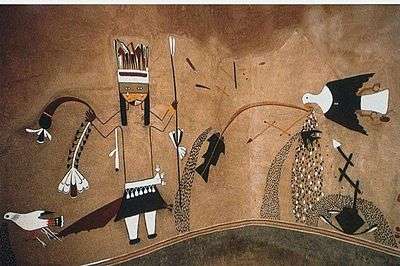Coronado Historic Site
|
Kuaua Ruin | |
|
Aerial view of Kuaua ruins, circa 1940 | |
  | |
| Location | Sandoval County, New Mexico, USA |
|---|---|
| Nearest city | Bernalillo, New Mexico |
| Coordinates | 35°19′46″N 106°33′27″W / 35.32944°N 106.55750°WCoordinates: 35°19′46″N 106°33′27″W / 35.32944°N 106.55750°W |
| Built | 1939 |
| Architect | John Gaw Meem |
| Architectural style | Pueblo |
| NRHP Reference # | 76001199[1] |
| Added to NRHP | January 1, 1976 |
Coronado, New Mexico's first state historic site to open to the public, was dedicated on May 29, 1940, as part of the Cuarto Centenario commemoration (400th Anniversary) of Francisco Vásquez de Coronado's entry into New Mexico. It is located along New Mexico Highway 550, 1 mile west of Bernalillo and 16 miles north of Albuquerque.[2]
Although it is named for Vasquez de Coronado, who camped in the vicinity in 1540–1542, this archeological site is most noted for the ruins of Kuaua pueblo. The pueblo or village was settled about 1325 and abandoned toward the end of the 16th century. Kuaua was one of several Tiwa-speaking pueblos in the area when the conquistador Vasquez de Coronado arrived, and the village was almost certainly abandoned due to the after effects of the Tiguex War (February 1541).
The ruins of Kuaua Pueblo were excavated in the 1930s by an archeological team led by Edgar Lee Hewett and Marjorie F. Tichy (later Lambert). The excavation revealed a south-to-north development over the village's three centuries of existence, as well as six kivas built in round, square and rectangular shapes. The site is particularly noted for a series of pre-contact (pre-1541) murals that were recovered from a square kiva in the pueblo's south plaza. These murals represent one of the finest examples of pre-contact Native American art to be found anywhere in North America. Fourteen of the restored murals are displayed in Coronado Historic Site's visitor center.
The visitor center itself was designed by Southwest architect John Gaw Meem and contains displays of Pueblo Indian and Spanish Colonial artifacts. An interpretive trail winds through the ruins and along the west bank of the Rio Grande.

References
|
|
- ↑ National Park Service (2008-04-15). "National Register Information System". National Register of Historic Places. National Park Service.
- ↑ Noble, David Grant, Ancient Ruins of the Southwest: An Archaeological Guide, Northland Publishing, Flagstaff, Arizona, 2000, p. 208
- ↑ "Coronado Historic Site". C-SPAN. February 7, 2013. Retrieved March 14, 2013.
External links
- Coronado Historic Site Blog An informative blog that is updated weekly with events and activities*
- Coronado Historic Site at New Mexico Historic Sites* American Southwest, a National Park Service Discover Our Shared Heritage Travel Itinerary
